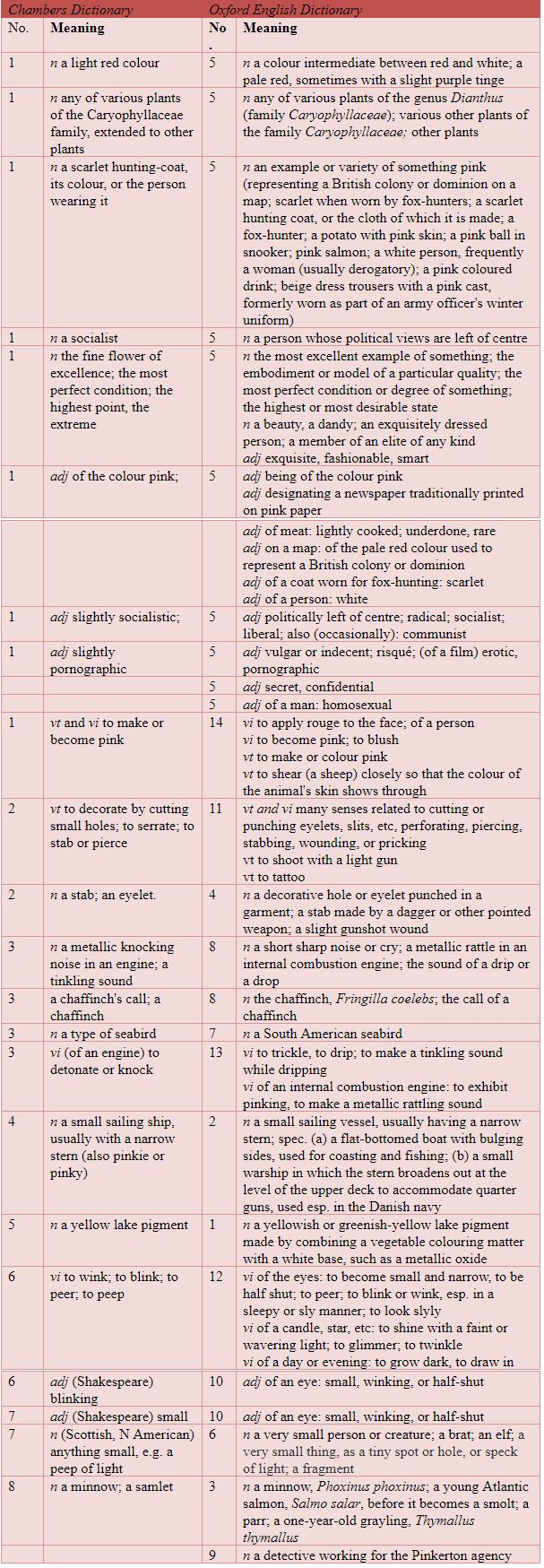 After the thumb, the index finger, the middle finger, and the ring finger, we come to the fifth digit, the little finger. It was known in Latin as digitus minimus, but in Scotland the little finger is often called the pinkie.
After the thumb, the index finger, the middle finger, and the ring finger, we come to the fifth digit, the little finger. It was known in Latin as digitus minimus, but in Scotland the little finger is often called the pinkie.
The Oxford English Dictionary lists 14 separate meanings for the word “pink”, nine nouns, four verbs, and an adjective; one of the nouns also includes adjectival uses. The Chambers Dictionary has eight entries, including seven nouns, four verbs, and three adjectives. The numerous meanings are listed in Table 1.

A major problem that arises when you try to sort out so many meanings is that their origins are not well understood. In two cases, “pink” is imitative of the sounds it names. In one case it is the shortened form of “Pinkerton”. And in one case it comes from a Middle Dutch word, pincke, a small sea-going ship or fishing-boat. The blinking, winking, peeping, peering meaning may come from an early modern Dutch word pincken, although that is by no means certain. In all the other cases the best the OED can do is to say that the origin is unknown or uncertain.
Add a -y or an -ie to pink and you get pinky or pinkie, meaning the little finger or the little toe. Pinkie could have come from any of the versions of pink that have something to do with smallness: the small sailing vessel, or to become small and narrow (of the eyes), or a very small thing, person, or creature, a fragment. The OED prefers the last of these.
Both of these suffixes, -y and -ie, are diminutives, commonly attached to people’s names, as in Annie, Billy, and Charlie, Richy, Sandy, and Tommy, and Franny and Zooey. Cricketers are particularly fond of nicknames formed in this way: Graham Gooch becomes “Goochy”, Shane Warne becomes “Warney”, and Alastair Cook becomes “Cooky”. Ordinary words can also be treated in this way: a bookie is a bookmaker and a nightie is a nightgown. So a pinkie is not just a tiny finger, it’s a teeny tiny one.
“Pinkie” entered English at the start of the 18th century, when it was used to mean (a) small or tiny and (b) narrow, winking, or half-shut, referring to the eyes. A century later it came to mean something very small or insignificant or a tiny thing, and at the same time the little finger and occasionally the little toe. In all of these meanings its use was predominantly Scottish. Indeed, its earliest recorded appearance is in John Jamieson’s Etymological Dictionary of the Scottish Language (1898). In contrast, “little finger” appears much earlier, in Old English texts.
Don’t underestimate the usefulness of the pinkie. A “pinkie technique” has been recommended when closing the abdominal wall after surgery. It involves the pinkie of the non-dominant hand, which holds the loop of a stitch and lifts it up to apply tension. What has been called “the pinkie maneuver” in colonoscopy involves hooking the left pinkie around the colonoscope to stabilize it. Alternatively, the “right pinkie maneuver” involves holding the shaft of the instrument with the right pinkie or the right ring finger and pinkie, freeing the right index finger and thumb for other tasks. On the other hand, one author has reported experiencing tenosynovitis through using the pinkie for colonoscopy in this way.

Of course, the pinkie is susceptible to other problems, such as Dupuytren’s contracture, tendon rupture, and tumours. Even minor things can be problematic, as a poem by Walter Wingate (1865–1918), “The Sair Finger”, illustrates:

Jeffrey Aronson is a clinical pharmacologist, working in the Centre for Evidence Based Medicine in Oxford’s Nuffield Department of Primary Care Health Sciences. He is also president emeritus of the British Pharmacological Society.
Competing interests: None declared.
